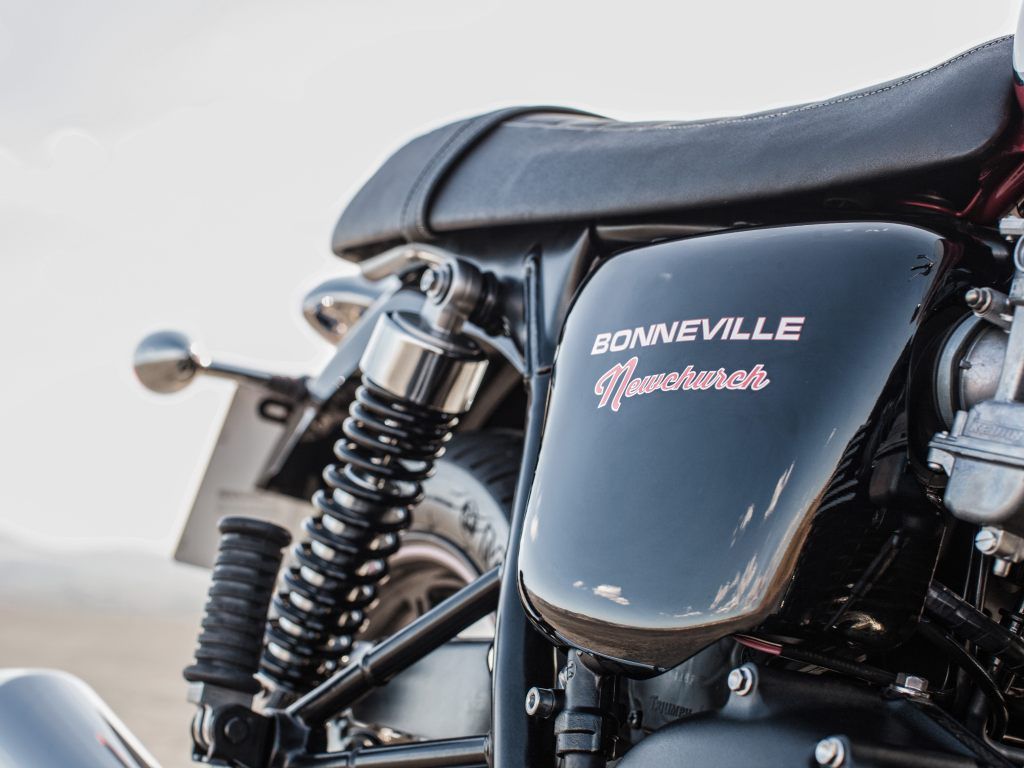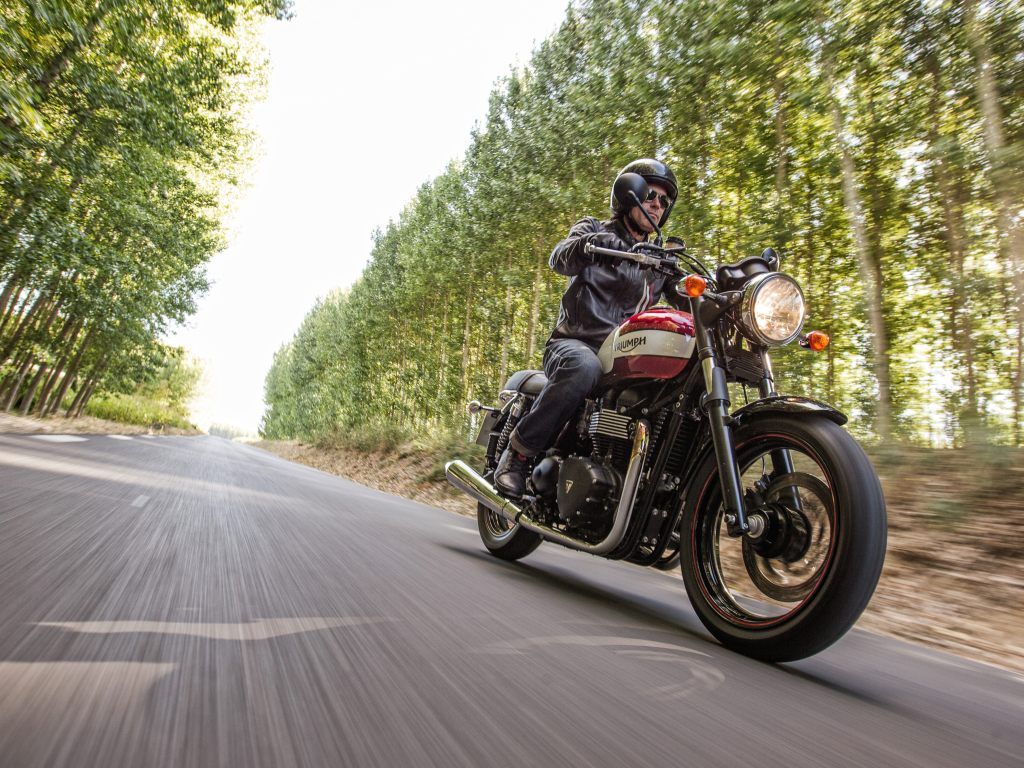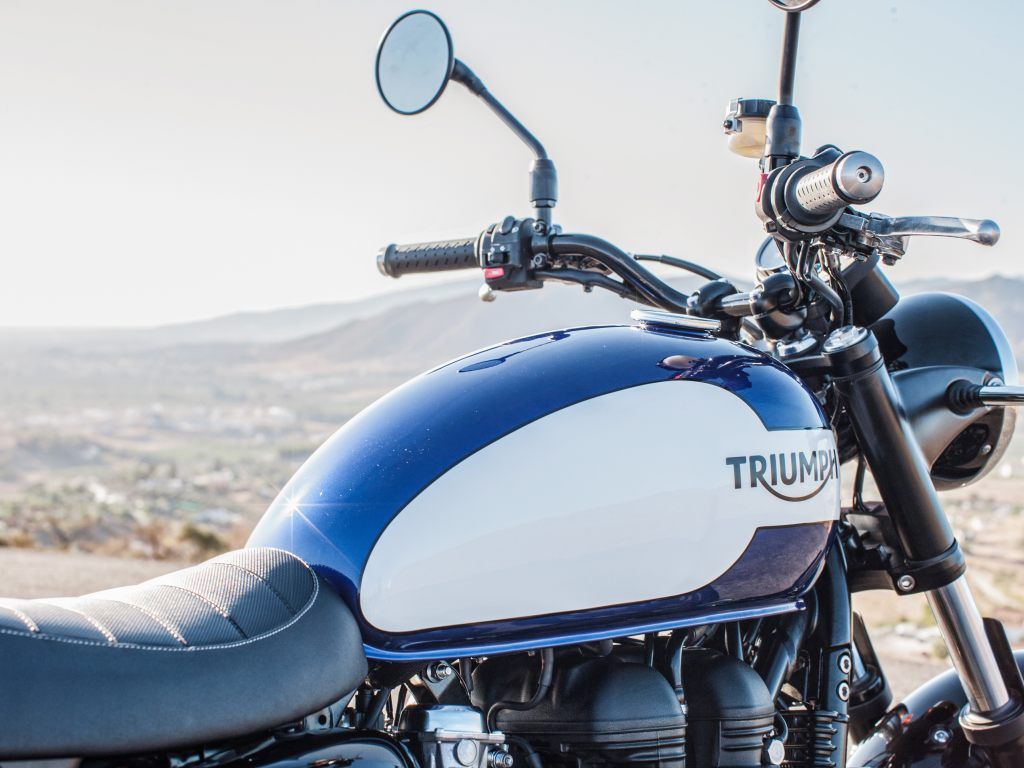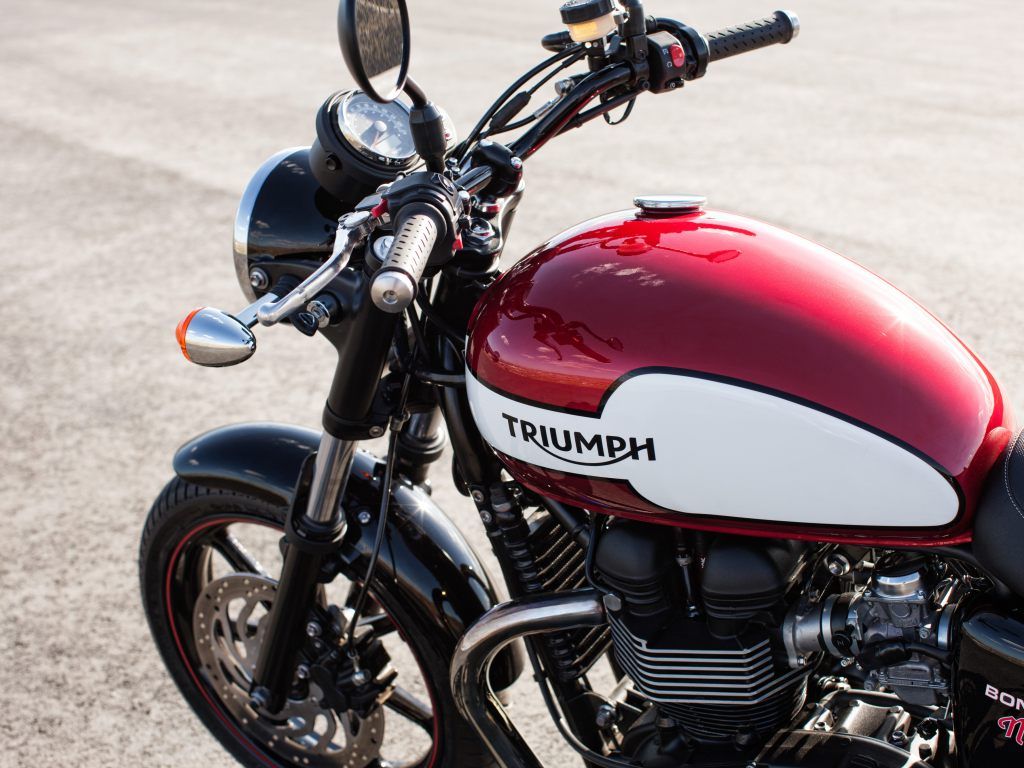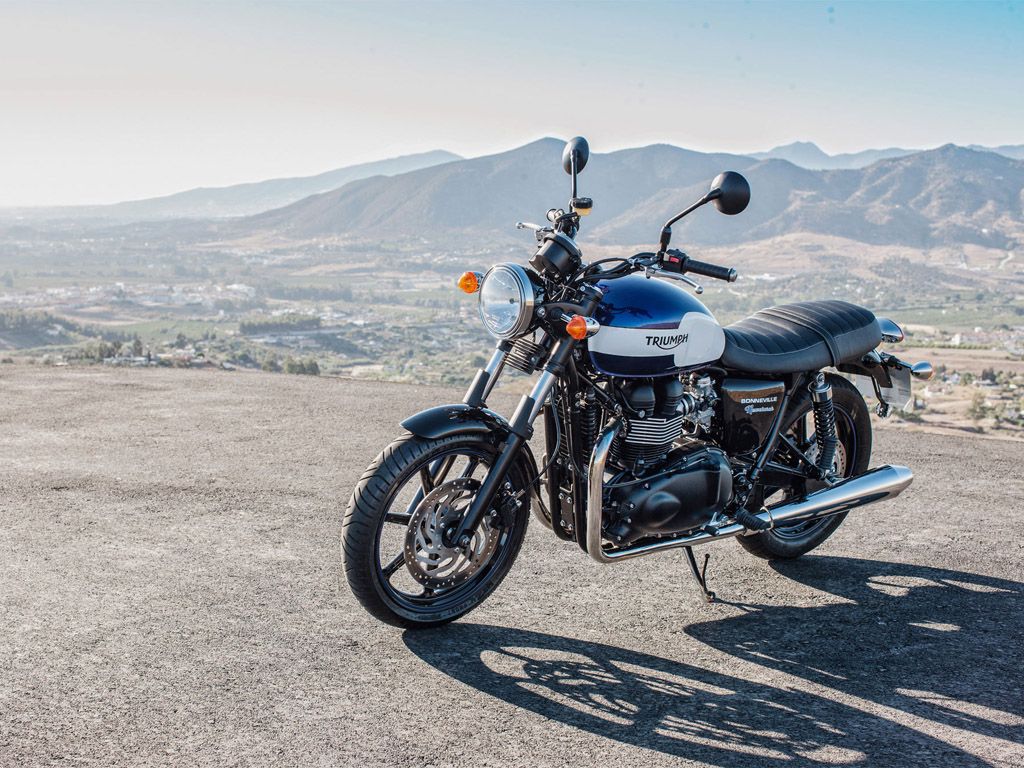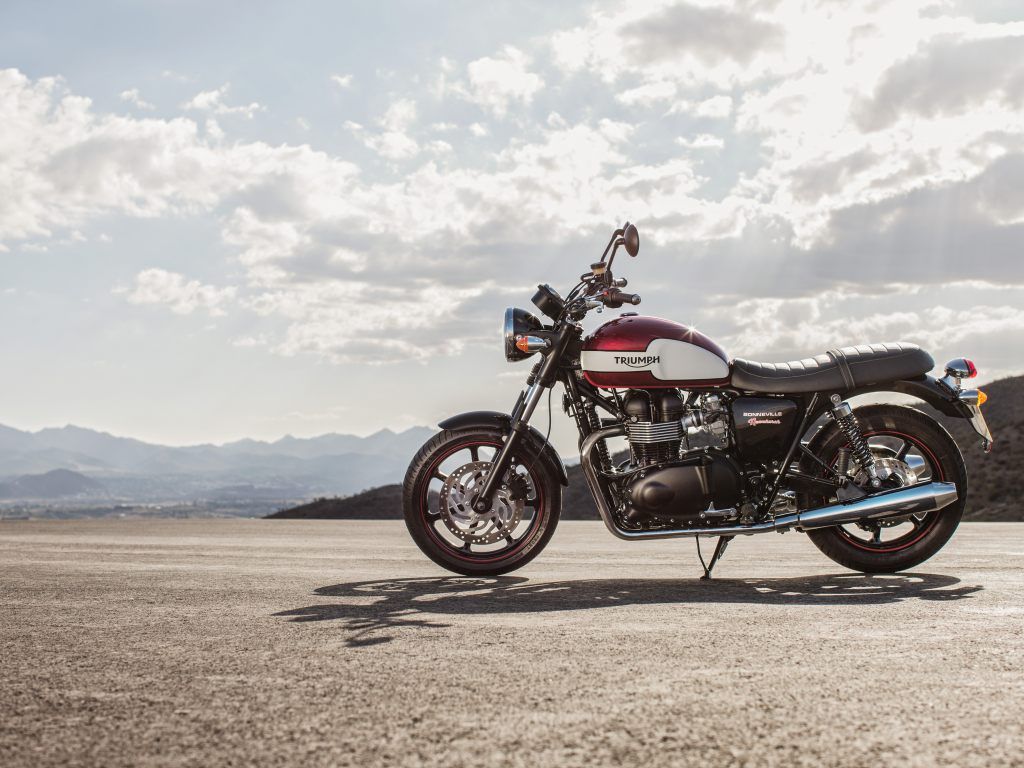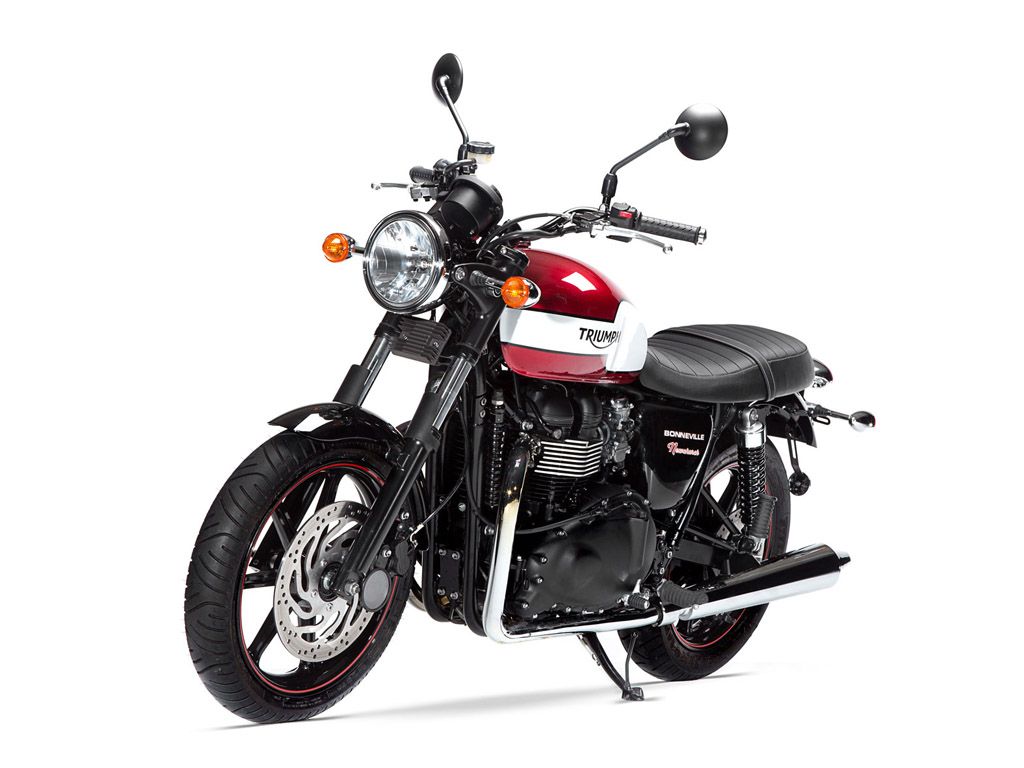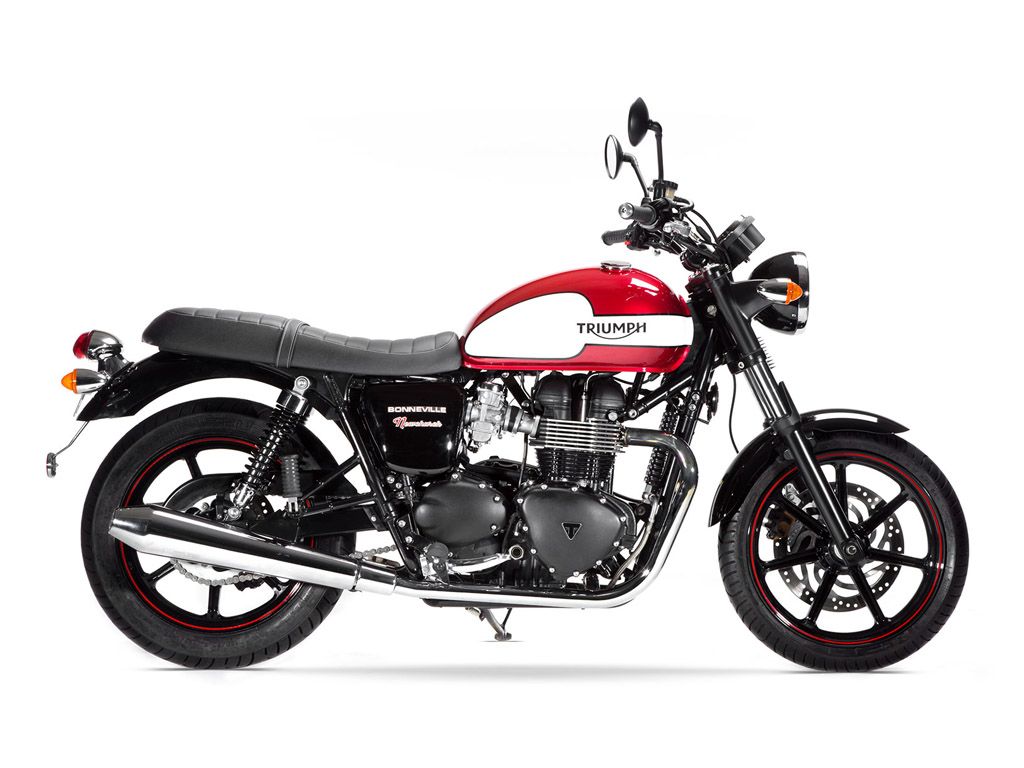Triumph->ke1864 acknowledges the passion of its fans with the release of the 2015 Bonneville->ke1865 Newchurch Special Edition -- the same passion which leads thousands of them to Neukirchen, Austria, for what is touted as the world's largest annual Triumph party. The Newchurch comes with a healthy dose of classic 1970's Bonnie features that will invoke a strong nostalgia in fans of that era, and personally, it does for me too. Granted, most of the Triumphs that I have dealt with have been choppers, but that's a story for another time. The parallel-twin engine looks like it could be 40 years old at a glance, but there is plenty of modern engineering treasure hidden within, and the 360 degree firing order undoubtedly gives the Newchurch that classic “twingle” sound (read: giant lawnmower) that so many associate with having a Brit in the pack.
2015 Triumph Bonneville Newchurch Special Edition
- Make: Array
- Model: 2015 Triumph Bonneville Newchurch Special Edition
- Engine/Motor: Air-cooled, DOHC, parallel-twin, 360º firing interval
- [do not use] Vehicle Model: Array
Design
Triumph went to extraordinary lengths to give the Newchurch its 1970's retro-vibe. I gotta say that I wish more manufacturers did this, even across to the automotive field. Yeah, I know that many designers “pay tribute” to earlier models, and then leave you searching for the tenuous threads of similarity. Not so with the Newchurch! The bike looks like a classic at a distance, from the lines made by the tank and seat to the cast-aluminum wheels. Get a little closer and you may notice the lack of a kickstarter, but you will have to start taking parts off to discover that the pushrod tubes are fake, and what looks like carburetors are actually cleverly designed throttle-bodies for the fuel-injection system. The only let-down for me from a design point of view would have to be the fuel tank. I miss the shape of the old tanks, with the reliefs on the trailing end of the sides. However, I must admit that the benefits of having more fuel capacity aren't lost on me, and the paint scheme does a good job of approximating the look of the old tank. The Newchurch tank comes in Bespoke Cranberry Red/Pure White or Sapphire Blue/Pure White, with black details on many components that one would normally expect to see chromed.
Chassis
In keeping with the 1970's design, the bike rides on seven-spoke wheels fore and aft that are engineered to be lighter than the originals that they mimic. The single front and rear disc brakes provide ample stopping power via the floating, twin-piston calipers. The 41 mm Kayaba hydraulic forks cushion the ride up front, with adjustable Kayaba spring-over shocks supporting the swingarm in the traditional fashion. The rear shock springs join the headlamp housing, handlebars, mirrors and fenders in the list of blacked-out details that gives the bike a bit of a custom flavor. Triumph touts the frame as being able to deliver classic Bonnie riding characteristics and modern handling at the same time, and the 29-inch seat height forces what it refers to as the “natural Bonneville riding position”. Not sure how this works out, but I will reserve my comments until after I get invited to the next Triumph test-ride event (wink nudge) rather than speculate.
Drivetrain
Triumph didn't abandon the retro look when it came time to plunk the tranny on the bike, but instead designed it to look like the classic, and the same is true of the engine. Housed within the iconic-looking engine are overhead cams, instead of the old lifter-and-pushrod system, operating four valves per cylinder to allow the engine to breathe efficiently and provide a rather sporty throttle response. The vibration from this response is tempered by the counter-shafts hidden within the crankcase to give a much smoother ride than its predecessor. Power flows to the rear wheel through the five-speed transmission and X-ring chain drive, and the progressive, multi-disc wet clutch should help tame the widely-spaced power pulses normally associated with twingles.
Pricing
The Newchurch can be had for $9,605 USD (€8,861) with the paint options and warranty included in that price. This price puts the Newchurch in the middle of the Sportster price range, so it is comparable in price and size, as well as traditional looks.
Competitor
Triumph motorcycles have always held a special place in the American heart, a sentiment that has historically placed it in direct competition with U.S. manufacturers, none more so than Harley-Davidson->ke300. Not only were the Brits popular, but they were generally accepted in situations that were considered “Harley-only” territory and the old twingles presented a real threat to both H-D and Indian->ke3292 in the hill-climbing events. It is against this backdrop that I decided to use the H-D Iron 883 Sportster for my head-to-head against the Newchurch Special Edition.
I've made much of the steps Triumph took to carry the Newchurch back to the '70s, but one could argue that the H-D Sportster never truly left that era, visually at least. Triumph gets points for its efforts to return the Newchurch to that era, and I think it did a bang-up job at that, so as cool as the Sporty looks, Triumph gains an edge in the aesthetics department.
I suppose both bikes qualify as cruisers, but they also fit within the barhopper subcategory. Add some bags and you could call it a grocery-getter as well, but no matter what you call it, these are fairly compact bikes. The 883 measures out at 88.8-inches long overall, just a skosh bigger than the Newchurch at only 83.2 inches, but still in the compact range to be sure. This difference in length is due mainly to steering stem angle. The Sporty runs a 30.5-degree rake while the Newchurch pulls the forks in to 27 degrees, which naturally shortens the vehicle.
Trail also differs slightly, and the 4.6-inch trail on the 883 will be a little more stable going straight than the Triumph, but the 4.17 inches on the Newchurch will make it a little more eager in the corners. As with anything else, it's a tradeoff. Suspension components are typical for this size bike, and neither offer anything beyond the ubiquitous preload adjuster on the rear shocks, and neither gains any advantage here. Brakes are likewise similar, but Harley offers ABS as a $795 option whereas Triumph doesn't offer it at all.
The 883 cc Evolution Sportster->ke1818 engine has been around for a while now, and it serves as Harley's go-to plant for the Iron while the Newchurch runs a more contemporary engine made to look like a much older mill. Both plants use cooling fins to dissipate waste heat, but Triumph takes the extra step of adding an oil cooler to protect the engines lifeblood and draw off even more engine-killing thermal energy.
Fuel-injection manages the induction across the board with similar results. Triumph claims an urban mileage of 51.2 mpg, while Harley reports a combined city/highway mileage of an even 51 mpg, so neither gains any advantage in the fuel-consumption department.
Harley actually comes out on top at the till. Depending on which paint package you choose, you can get an Iron 883 for either $8,399 or $9,149, while the Newchurch Special Edition comes with a $9,605 starting price. That's only a minor victory, and to someone like myself, the classic look of the Trumpet is enough to justify a little extra expense.
He Said
"I love that Triumph didn't gently suggest at the era they were going for, they shoved it right in our face! This bike's roots are impossible to ignore, and they have gone even further than Harley did with the Street model family in trying to capture the look of the old Cafe' Racers. This is one Brit that I would love to have for putt-putting around town, though much like my Sporty, I doubt that I would want to do any long-distance riding on it.
She Said
My wife and fellow writer says, "I love the classic look -- a real classic look and not just the suggestion of a bygone time. It looks so much like Triumph from my high school days that I expect it to start leaking oil. Ah, the good ol' days."
Specifications
|
Engine Type: |
Air-Cooled, DOHC, Parallel-Twin, 360-Degree Firing Interval |
|
Capacity: |
865 cc |
|
Bore: |
90 mm |
|
Stroke: |
68 mm |
|
Fuel System: |
Multipoint Sequential Electronic Fuel Injection With SAI |
|
Exhaust: |
Stainless Steel Headers, Twin Chromed Upswept Silencers |
|
Final Drive: |
X Ring Chain |
|
Clutch: |
Wet, Multi-Plate |
|
Gearbox: |
5-Speed |
|
Oil Capacity: |
4.75 quarts |
|
Frame: |
Tubular Steel Cradle |
|
Swingarm: |
Twin-Sided, Tubular Steel |
|
Front Wheels: |
Cast Aluminum Alloy, 7-Spoke, 17 X 3.0 Inch |
|
Rear Wheels: |
Cast Aluminum Alloy, 7-Spoke, 17 X 3.5 Inch |
|
Front Tires: |
110/70 R17 |
|
Rear Tires: |
130/80 R17 |
|
Front Suspension: |
Kayaba 41mm Forks, 120 mm Travel |
|
Rear Suspension: |
Kayaba Chromed Spring Twin Shocks With Adjustable Preload, 100 mm Rear |
|
Brakes Front: |
Single 310 mm Disc, Nissin 2-Piston Floating Caliper |
|
Brakes Rear: |
Single 255 mm Disc, Nissin 2-Piston Floating Caliper |
|
Instrument Display And Functions: |
Analogue Speedometer With Odometer, Clock And Trip |
|
Information: |
|
|
Length: |
83.26 inches |
|
Seat Height: |
29 inches |
|
Wheelbase: |
58.6 inches |
|
Rake: |
27 degrees |
|
Trail: |
4.17 inches |
|
Tank Capacity: |
4.2 gallons |
|
Wet Weight: |
496 pounds |
|
Dry Weight: |
460 pounds |
|
Max Power: |
68 brake horsepower at 7,500 rpm |
|
Max Torque: |
50.2 pound-feet at 5,800 rpm |
|
Fuel Consumption Urban: |
51.2 mpg |
|
Fuel Consumption56mph/90kph: |
68.0 mpg |
|
Fuel Consumption75mph/120kph: |
55.6 mpg |
|
Color Options: |
Lunar Silver, Phantom Black |


